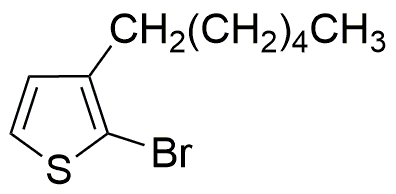2-Bromo-3-hexylthiophene is widely utilized in research focused on:
- Organic Electronics: This compound is a key material in organic semiconductors, enhancing the performance of organic solar cells and transistors due to its excellent charge transport properties.
- Photovoltaic Applications: It plays a significant role in the development of efficient photovoltaic devices, contributing to higher energy conversion efficiencies compared to traditional materials.
- Conductive Polymers: Used in the synthesis of conductive polymers, it helps improve the electrical conductivity and stability of materials used in flexible electronic applications.
- Sensor Technology: The compound is utilized in the fabrication of chemical sensors, offering high sensitivity and selectivity for detecting various analytes, which is crucial in environmental monitoring.
- Research in Material Science: It serves as a building block for novel materials, allowing researchers to explore new functionalities and applications in nanotechnology and advanced materials.
General Information
Properties
Safety and Regulations
Applications
2-Bromo-3-hexylthiophene is widely utilized in research focused on:
- Organic Electronics: This compound is a key material in organic semiconductors, enhancing the performance of organic solar cells and transistors due to its excellent charge transport properties.
- Photovoltaic Applications: It plays a significant role in the development of efficient photovoltaic devices, contributing to higher energy conversion efficiencies compared to traditional materials.
- Conductive Polymers: Used in the synthesis of conductive polymers, it helps improve the electrical conductivity and stability of materials used in flexible electronic applications.
- Sensor Technology: The compound is utilized in the fabrication of chemical sensors, offering high sensitivity and selectivity for detecting various analytes, which is crucial in environmental monitoring.
- Research in Material Science: It serves as a building block for novel materials, allowing researchers to explore new functionalities and applications in nanotechnology and advanced materials.
Documents
Safety Data Sheets (SDS)
The SDS provides comprehensive safety information on handling, storage, and disposal of the product.
Product Specification (PS)
The PS provides a comprehensive breakdown of the product’s properties, including chemical composition, physical state, purity, and storage requirements. It also details acceptable quality ranges and the product's intended applications.
Certificates of Analysis (COA)
Search for Certificates of Analysis (COA) by entering the products Lot Number. Lot and Batch Numbers can be found on a product’s label following the words ‘Lot’ or ‘Batch’.
*Catalog Number
*Lot Number
Certificates Of Origin (COO)
This COO confirms the country where the product was manufactured, and also details the materials and components used in it and whether it is derived from natural, synthetic, or other specific sources. This certificate may be required for customs, trade, and regulatory compliance.
*Catalog Number
*Lot Number
Safety Data Sheets (SDS)
The SDS provides comprehensive safety information on handling, storage, and disposal of the product.
DownloadProduct Specification (PS)
The PS provides a comprehensive breakdown of the product’s properties, including chemical composition, physical state, purity, and storage requirements. It also details acceptable quality ranges and the product's intended applications.
DownloadCertificates of Analysis (COA)
Search for Certificates of Analysis (COA) by entering the products Lot Number. Lot and Batch Numbers can be found on a product’s label following the words ‘Lot’ or ‘Batch’.
*Catalog Number
*Lot Number
Certificates Of Origin (COO)
This COO confirms the country where the product was manufactured, and also details the materials and components used in it and whether it is derived from natural, synthetic, or other specific sources. This certificate may be required for customs, trade, and regulatory compliance.


